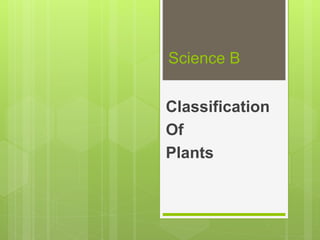
Classification of Plants, divisions of plants.pptx
- 4. Kingdom Plantae The group of autotrophic living organisms having eukaryotic cells with cell walls is the group of plants. Plants have become autotrophic as they can perform photosynthesis with the help of chlorophyll. Living organisms of kingdom plantae are the main source of food for all other living organisms.
- 5. Basis For Classification: 1)Presence or Absence of Organs. 2)Presence or Absence of separate conducting tissues for conduction of water and food 3)Plants bear seeds? If they do then, whether the seeds are enclosed in a fruit or not. 4)The number of cotyledons in the seeds.
- 6. Cryptogams A cryptogam is a plant that reproduces by spores, without flowers or seeds. "Cryptogamae" means hidden reproduction, referring to the fact that no seed is produced, thus cryptogams represent the non-seed bearing plants. Cryptogams are classified into 3 groups. 1) Thallophyta 2) Bryophyta 3) Pteridophyta
- 7. 1)Thallophyta It has two types of Plants. 1) Algae: This group of plants, which do not have specific parts like root- stem-leaves-flowers but are autotrophic due to the presence of chlorophyll, is called algae. Algae show great diversity. They may be unicellular or multicellular, and microscopic or large. Examples of algae are Spirogyra, Ulothrix, Ulva, Sargassum, etc. Some of these are found in fresh water while some are found in saline water.
- 8. 2) Fungi: These plants usually have a soft and fibre-like body. Various types of fungi like yeasts and moulds which do not have chlorophyll are also included in this group.
- 10. 2) Bryophyta This group of plants is called the ‘amphibians’ of the plant kingdom because they grow in moist soil but need water for reproduction. These plants are thalloid, multicellular and autotrophic. They reproduce by spore formation. They do not have specific tissues for conduction of food and water. Examples are Moss (Funaria), Marchantia, Anthoceros, Riccia, etc.
- 11. The structure of the plant body of bryophytes is flat, ribbon-like long, without true roots, stem and leaves. Instead, they have stem-like or leaf-like parts and root-like rhizoids.
- 13. 3) Pteridophyta Plants from this group have well-developed roots, stem and leaves and separate tissues for conduction of food and water. But, they do not bear flowers and fruits. They reproduce with the help of spores formed along the back or posterior surface of their leaves. Examples are ferns like Nephrolepis, Marsilea, Pteris, Adiantum, Equisetum, Selaginella, Lycopodium, etc.
- 14. These plants reproduce asexually by spore-formation and sexually by zygote formation. They have a well-developed conducting system.
- 15. All these plants reproduce by spore formation. They are called cryptogams as their reproductive organs cannot be seen. (cryptos: hidden, gams: reproductive organs).
- 16. PHANEROGAMS -special structures for reproduction. -produces seeds. -seeds are formed which contain the embryo and stored food. -the stored food is used for the initial growth of the embryo. -phanerogams are classified into gymnosperms and angiosperms. -Classification is don on basis of seed structure and position.
- 17. 1) GYMNOSPERMS Seeds of these plants do not have natural coverings, i.e. these plants do not form fruits and are therefore called gymnosperms. (gymnos: naked, sperms: seeds).
- 18. Gymnosperms are mostly evergreen, perennial and woody. CYCAS
- 19. The stems of Gymnosperms are without branches. Picea (Christmas tree)
- 20. The leaves form a crown Thuja (Morpankhi)
- 21. These plants bear male and female flowers on different sporophylls of the same plant.
- 22. 2)ANGIOSPERMS The flowers these plants bear are their reproductive organs. Flowers develop into fruits and seeds are formed within fruits. Thus, these seeds are covered; hence, they are called angiosperms. (angios: cover, sperms: seeds).
- 23. Any of a class of angiosperm plants having a single cotyledon in the seed. Onion Seed Corn Seed MONOCOTYLEDON
- 24. DICOTYLEDONS Dicotyledonous definition is - any of a class of angiosperms plants that produce an embryo with two cotyledons.